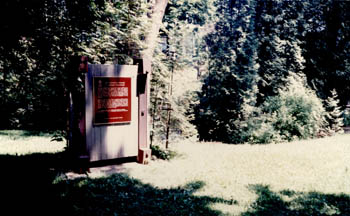Normandale Furnace National Historic Site of Canada
Normandale, Ontario

Plaque location
(© Parks Canada Agency | Agence Parcs Canada)
Address :
Normandale, Ontario
Recognition Statute:
Historic Sites and Monuments Act (R.S.C., 1985, c. H-4)
Designation Date:
1927-05-19
Dates:
-
1818 to 1850
(Construction)
Other Name(s):
-
Normandale Furnace
(Designation Name)
-
Normandale Blast Furnace
(Plaque name)
Plaque(s)
Existing plaque: Mill Lane, Normandale, Ontario
One of Upper Canada’s most important industrial enterprises, the Normandale ironworks and its blast furnace played a significant role in the early economic development of the province. Built in 1816-1817 by John Mason, and enlarged in 1821-1822 by Joseph Van Norman, Hiram Capron, and George Tillson, it produced the famous Van Norman cooking stove, as well as iron kettles, pots and pans, and agricultural implements. Up to 200 men were employed prior to the closure of the blast furnace in 1847, following the exhaustion of the local bog ore deposits.
*Note: This designation has been identified for review. A review can be triggered for one of the following reasons - outdated language or terminology, absence of a significant layer of history, factual errors, controversial beliefs and behaviour, or significant new knowledge.
Description of Historic Place
Normandale Furnace National Historic Site of Canada is situated near a creek mouth on Lake Erie’s shoreline in Normandale, Ontario. Between 1818 and the late 1840s Normandale Furnace was a significant producer of cast and wrought iron products for domestic, agricultural and industrial use. The foundry has no visible remains on its former hillside site other than slag fragments in the river. The site, on Mill Lane is now overgrown by trees. A Historic Sites and Monuments Board of Canada plaque is located just west of the Creek. Official recognition refers to the plot of land located on the south side of the Village of Normandale that extends south to the south bank of Normandale Creek.
Heritage Value
Normandale Furnace was designated as a national historic site of Canada in 1927. It is designated because:
— this iron foundry was one of Upper Canada’s most important early industrial enterprises producing stoves, kettles, pots, pans domestic and farm implements between 1818 and the late 1840s.
The Normandale Furnace was a factor in the early economic and industrial development of this country. Noted as the first successful iron industry in Ontario, Normandale Furnace was founded in 1818 by English ironmaster John Mason. Dying in 1820, Mason left the foundry to his widow, who sold it to Joseph Van Norman, Hiram Capron and George Tillson. Between 1822 until 1829, the furnace underwent significant enlargement and increased its workforce to 20 men. In 1829, Elijah Leonard joined the foundry as furnace superintendent, supervising the mixing of ore and charcoal. Relying on locally dug iron ore and wood the Normandale Furnace provided economic stimulus to the region. By its peak in 1840, as many as two hundred men were involved in the process and Normandale Furnace was producing 750 tons of cast and wrought iron products for domestic, agricultural and industrial use, including the famous Van Norman cooking stove. However, by 1847, the local bog ore supply was so depleted that Normandale Furnace closed.
Sources: Historic Sites and Monuments Board of Canada, Minutes, 1929, October 2012.
Character-Defining Elements
Key elements that contribute to the heritage character of the site include:
— its strategic location on Mill Lane, near Lake Erie, less than one kilometre outside Normandale, Ontario;
— the integrity of any surviving landscape features, objects, machinery and structural or archaeological remains, that date to the period of the foundry’s operation, which may be found within the site in their original placement and extent;
— its setting in a wooded landscape surrounded by mature trees.